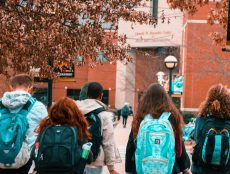
This article was written by Brian Lamb, the CEO of Swivl, an eLearning provider, specialising in classroom management.
Creativity is involved at every stage of education, from young children in art class to higher ed students working on a research project. What used to be considered just a human process, creativity has now become a focus of new technology solutions like artificial intelligence. As the use of AI in education continues to evolve, so will the boundaries and possibilities of creativity.
When the World Wide Web was first released in 1993, many humans were unsure of this innovative technology. Since then, humans have adapted and become more knowledgeable of the internet’s uses. Now, it plays a vital role in our everyday lives, from academics to careers and personal use.
A similar movement is happening with AI, and we’re just scratching the surface. Undoubtedly, the recent development of AI has already and will continue to impact human’s creative future.
From being trained on dramatically more information at a faster rate than humans to making more and better connections, AI is causing us — especially educators — to change our definition of creativity. While much is still unknown about AI implementation in education, many educators and parents question its long-term implications on students’ creative abilities.
What’s the solution for the future? Higher-order creativity.
What is Higher-Order Creativity?
Starting off, higher-order thinking is the process where humans think about thinking while also regulating thinking, otherwise known as metacognition. In the case of creativity, those employing higher-order thinking can think about how they can simultaneously create, recognize, and overcome their impulses during the most challenging parts of creativity.
These challenging parts of the process are almost guaranteed and can include fear of criticism and a lack of motivation.
Creating new, innovative ideas is just the first step in creativity. Humans with higher-order creativity can take it further by honestly evaluating their ideas and making necessary adjustments, and in the process, building their resilience to the obstacles and developing a willingness to iterate and keep going in the creative process.
For most students, the potential of failure is one of the most significant factors that causes them to give up during any learning or creative process. A new study from the Annals of the New York Academy of Science showed that high school students’ mindsets impacted how likely they were to view an academic setback as a permanent failure. After interviewing 300 high school students from across the country, researchers found students’ most common responses to setbacks were so-called “high arousal emotions” such as anger, shame, and frustration. While these reactions may lead to venting from students, they can also negatively impact their energy and motivation.
Because the fear of failure can be so extreme, students now rely on technology, specifically AI, to make things easier in the classroom. However, becoming too reliant on technology to think for themselves can hurt the development of skills they need to build intrinsic motivation while in school and even succeed in life after school. Instead, they should focus on building a strong sense of self-awareness.
The Need for Higher Order Skills and Meta-Creativity
Making these changes can be difficult for educators and students alike, but meta-creativity can be achieved using reflective tools. These tools allow students to enhance their creativity and other critical skills to high order while they use AI for appropriate uses.
Routines that can help students fully engage with the creativity process can be something as simple as mindful breathing. When educators create an environment where students are encouraged to stop what they’re doing when they hit a setback and calm down and refocus with breathing exercises, this will not only have a positive impact on the assignment they’re currently working on — it will also start creating positive habits for projects further down the road. This practice is especially important because AI isn’t going anywhere, so the earlier students know how to adapt and use AI alongside reflective learning techniques intentionally, the better for their personal and academic success.
People, especially students, inherently don’t know how to reflect well. With higher-order thinking, students must learn to reflect on their thinking, process, and even how they connect with others in group settings. As AI continues to be used in the classroom, students must be ready to push past their initial thoughts and take the next steps to set goals and achieve them.
Many education thought leaders might think schools aim to lessen creativity in their students. However, I think the constraints schools provide during students’ early years, including strict schedules and emphasis on traditional grading success, will significantly benefit them when they enter the “real world” as adults. Suppose students are shown how to use technology and higher-order creativity as a routine part of their educational schedules. In that case, they will be more mindful, adaptable adults, thriving in an independent, innovative culture that will only be enhanced by more technology.
Artificial intelligence is revolutionizing every industry, and its impact on education has just scratched the surface. AI’s impact on creativity can become harmful if humans don’t learn to adjust their higher-order thinking and skills. By becoming more aware, flexible, and reflective with their routines and the tools they use, humans can have exponential limits of success when using AI in the classroom.
Academic success is traditionally tied to setting goals attached to a completed project or associated with perfectionism. Manage the impulse of giving up when confronted with failure or criticism, the image of academic success and the function of creativity as a higher-order skill will both change. Eventually, this academic success will lead to long-term growth and success when their school journey is over.
If you liked this article, check out How eLearning Transforms Education for Autistic Children.
Featured image credit: dorian2013, iStock.









No Comments